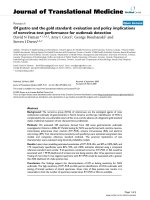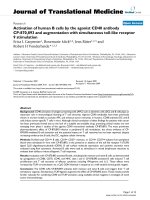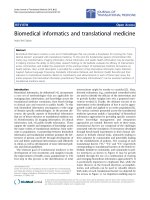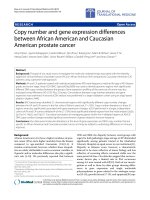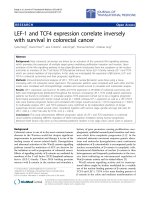Báo cáo hóa học: " Cell Creeping and Controlled Migration by Magnetic Carbon Nanotubes" ppt
Bạn đang xem bản rút gọn của tài liệu. Xem và tải ngay bản đầy đủ của tài liệu tại đây (332.73 KB, 6 trang )
NANO IDEAS
Cell Creeping and Controlled Migration by Magnetic Carbon
Nanotubes
V. Raffa
•
O. Vittorio
•
G. Ciofani
•
V. Pensabene
•
A. Cuschieri
Received: 28 March 2009 / Accepted: 5 October 2009 / Published online: 27 October 2009
Ó to the authors 2009
Abstract Carbon nanotubes (CNTs) are tubular nano-
structures that exhibit magnetic properties due to the metal
catalyst impurities entrapped at their extremities during
fabrication. When mammalian cells are cultured in a CNT-
containing medium, the nanotubes interact with the cells, as
a result of which, on exposure to a magnetic field, they are
able to move cells towards the magnetic source. In the
present paper, we report on a model that describes the
dynamics of this mammalian cell movement in a magnetic
field consequent on CNT attachment. The model is based on
Bell’s theory of unbinding dynamics of receptor-ligand
bonds modified and validated by experimental data of the
movement dynamics of mammalian cells cultured with
nanotubes and exposed to a magnetic field, generated by a
permanent magnet, in the vicinity of the cell culture wells.
We demonstrate that when the applied magnetic force is
below a critical value (about F
c
& 10
-11
N), the cell
‘creeps’ very slowly on the culture dish at a very low
velocity (10–20 nm/s) but becomes detached from the
substrate when this critical magnetic force is exceeded and
then move towards the magnetic source.
Keywords Cell creeping and migration Á
Carbon nanotubes Á Magnetism
Introduction
Carbon nanotubes (CNTs) [1] are molecular-scale tubes of
graphite carbon with unique properties including extreme
strength, electric properties and other characteristics [2],
which account for their large scientific and industrial
interest with thousands of original publications on nano-
tubes being reported every year. CNTs are either single-
wall CNTs (SWCNTs) consisting of a single graphite lattice
rolled into a perfect cylinder or multi-wall CNTs
(MWCNTs) made up of several concentric cylindrical
graphite shells. One characteristic that accounts for their
scientific and clinical relevance to the biomedical field is the
ability of CNTs to penetrate plasma membranes. This
property has driven research and development, which has
resulted in significant advances in CNT chemistry and
functionalization specifically for the use of CNTs as vectors
for the delivery of a spectrum of therapeutic substances,
e.g., peptides, proteins, nucleic acids and drugs, to cells and
tissues [3]. More recent reported biological studies have
been based on work, which has exploited their unique
physical properties. These include the strong near infrared
absorbance by SWCNTs for tumour cell ablation [4], bac-
terial electroporation by field emission properties of
MWCNTs [5] and localized heat release from SWCNTs
following application of a radiofrequency radiation also for
thermal ablation of cancer [6]. CNTs also possess intriguing
magnetic properties, which derive from the metal catalyst
impurities entrapped at CNT extremities during their man-
ufacture, enabling them to react to external magnetic fields.
This property has been utilized by Cai et al. to develop an
alternative physical method of nanotube ‘spearing’ for in
vitro and in vivo gene transfection of cells with plasmid
DNA [7]. Monch et al. have shown that ferromagnetic filled
carbon nanotubes can interact with human bladder cancer
V. Raffa (&) Á O. Vittorio Á A. Cuschieri
Medical Science Lab, Scuola Superiore Sant’Anna,
Piazza Martiri della Liberta
`
33, 56127 Pisa, Italy
e-mail:
G. Ciofani Á V. Pensabene
CRIM Lab, Scuola Superiore Sant’Anna,
Viale R. Piaggio 34, 56025 Pontedera (PI), Italy
V. Pensabene
IIT, Italian Institute of Technology, 16125 Genoa, Italy
123
Nanoscale Res Lett (2010) 5:257–262
DOI 10.1007/s11671-009-9463-y
EJ28 cells [8]. Based on this magnetic property, we have
recently demonstrated that MWCNTs when exposed to a
magnetic field are able to interact with cells and induce their
migration towards the magnetic source [9]. Controlled
migration of mammalian cells could have important
potential clinical applications, e.g., in cancer therapy to
curtail the metastatic behaviour of invasive cancer [10],
accelerating regeneration after peripheral nerve injuries,
etc. In the present paper, we report on the measurement and
modelling of CNT-induced cell movement. Mammalian
cells cultured with MWCNTs were tracked and studied for
3 days in order to document and measure their migration
dynamics. These data were then used to develop and vali-
date a model, which describes this CNT-induced cell
movement in a magnetic field.
Materials and Methods
Sample Preparation
MWCNTs fabrication is based on the synthesis of carbon
nanostructures by catalytic chemical vapour deposition
(CCVD) of hydrocarbon sources on substrates of alumina
impregnated with metal catalysts (Fe) [11]. This fabrication
process produces nanotubes with a diameter of 20–40 nm
and a carbon content of 97.06%, less than 1% of which
being amorphous [12] and bulk density of 0.15 g/cm
3
. Non-
covalent coating of the CNTs was performed with Pluronic
F127 (PF-127, polyoxyethylene-polyoxypropylene block
copolymer supplied by Sigma, St. Louis, MO), a water
soluble surfactant with MW = 12,600 as previously
reported [13]. Briefly, an aqueous solution of PF-127
(0.1%) containing 0.5 mg/mL of MWCNTs was heated
(70 °C) on a hot plate with magnetic stirring for 4 h. The
resulting mixture was sonicated (2510 Bransonic sonicator,
CT, USA) at 20 W for 12 h. The mixture was then centri-
fuged at 900 g for 10 min to remove non-dispersed nano-
tubes. The concentration of the CNT solution measured by
spectrophotometric analysis [14] at 270 nm averaged
100 lg/mL. For the evaluation of the effects of the sur-
factant, the sample was inspected by Focused Ion Beam
(FIB) microscopy [15] (FEI 200 system delivering 30 keV
beam of gallium ions). A drop of this solution was deposited
on a silicon wafer fragment and dried for 2 h inside a
laminar flow cabinet. FIB imaging revealed an average
MWCNT length of 2 ± 0.6 lm (Fig. 1).
Magnetic Characterization
MWCNTs produced by CCVD have magnetic nanoparti-
cles enmeshed in their tips [9], which enable their response
to external magnetic fields. Analysis of metal impurities
revealed the presence of Al and Fe, derived, respectively,
from the alumina support and the catalyst used in the
fabrication process. The total metal content (estimated by
inductive coupled plasma mass spectrometry) was 2.94%
(w/w), and the ratio Fe/Al is 7 ± 1 (w/w) [12]. The mag-
netic properties of the carbon nanotubes used in these
experiments were analysed by the use of a SQUID mag-
netometer (MPMSXL-7, Quantum Design). The magneti-
zation curve was recorded for solid samples of 5 mg of
CNTs. Measurements were performed at 37 °C with an
applied magnetic field up to 20,000 Oe. The analysis
showed a magnetization curve typical of paramagnetic
materials (Fig. 2), with a coercivity of about -400 Oe and
a remanence of about 0.44 emu/g. Saturation magnetization
(ms) was about 1.6 emu/g for a field of about 5,000 Oe.
Fig. 1 FIB imaging of a as produced MWCNT and b a drop of MWCNT dispersion
258 Nanoscale Res Lett (2010) 5:257–262
123
Cell Culture
Human SH-SY5Y cells (ATCC CRL-2266) were grown
using a mixture (1:1) of Ham’s F12 and DMEM supple-
mented with 2 mM
L-glutamine, 100 IU/mL penicillin,
100 lg/mL streptomycin and 10% heat-inactivated fetal
bovine serum (FBS). Cells were maintained at 37 °Cina
saturated humidity atmosphere containing 95% air/5% CO
2
.
CNT-modified medium was obtained by adding PF-127
coated MWCNTs to the cell culture medium at a ratio 1:10
(v/v). Spectrometric and FIB analyses performed over
5 weeks from sample preparation revealed a great stability
of the solution (no phenomena of nanotube aggregation or
precipitation). Lipofectamine (GenePORTER 2; Genlantis,
San Diego, CA) was used for the transfection of a plasmid
DNA containing a green fluorescent protein (gfp) gene
reporter in SH-SY5Y cells according to the protocol pro-
vided by the supplier. After transfection, cells were cultured
without any experimental manipulation for 24 hours before
any further experimental testing. The transfection efficiency
was about 80% (percentage of GFP-positive cells counted
by fluorescent microscopy). Optical and fluorescent
microscopy was performed with a Nikon TE2000U fluo-
rescent microscope equipped with Nikon DS-5MC USB2
cooled CCD camera. To determine the effect of carbon
nanotubes and the surfactant on cell viability, we used
WST-1 (tetrazolium salt 2-(4-iodophenyl)-3-(4-nitophe-
nyl)-5-(2,4-disulfophenyl)-2H-tetrazoilium) cell prolifera-
tion assay. Then, 25 9 10
3
cells were seeded into each well
of a 96-well plate and then incubated with the culture media
for 72 h. The culture medium was then replaced with
100 lL of medium containing 10 lL of WST-1 solution (as
described in quick cell proliferation assay kit, BioVision,
USA) and incubated for 2 h in standard conditions. The
absorbance was measured on a Versamax microplate reader
(Molecular Devices, Sunnyvale, CA) at a wavelength of
450 nm with background subtracted at 650 nm.
Cell Migration Assays
SH-SY5Y cells were mixed with GFP-expressing cells in a
ratio 10,000:1. Cells were cultured in 6-well plates. A grid
was applied at the bottom of the wells to measure the cell
displacement. The grid, printed on a transparent sheet with
a laser printer (30 lm resolution), had an inter-circle line
distance of 500 lm. The cells were seeded at a concen-
tration of 10
5
cells/well and incubated for 6 h to allow cell
attachment. Cell culture medium was then replaced with
CNT-modified medium. After 2 h of incubation, a magnet
was placed close to the well. The magnet used was a
neodymium cubic magnet (N48, Residual Induction
B
r
= 1.41 T, cube late a = 12 mm), which produces the
magnetic flux density showed in Fig. 3.
Statistics
Values are reported as mean ± standard error of the mean
(S.E.M.). The WST-1 experiments were carried out in trip-
licate. One-way statistical analysis of variance (ANOVA)
followed by post hoc comparison test (Turkey test) was
performed; a P value \0.001 was considered significant.
Results and Discussion
Cell Migration on Exposure to a Magnet Field
In our previous work, we demonstrated that SH-SY5Y cells,
cultured with a cell culture medium modified with PF-127
coated CNTs, are able to migrate under the effect of an
external magnetic field [9] towards the magnetic source. No
such displacement was detected in control dishes when cells
were cultured in a CNT-free cell culture medium. In the
present study, in vitro assays were performed in order to
follow the migration dynamics of isolated cells. The fluo-
rescent (target) cells were identified in the well and their
exact position determined at 0, 24, 48 and 72 h after
placement of the magnet. Figure 4 compares the displace-
ments of the cells treated with the CNTs and exposed to the
magnetic field (a) to control cells that are not exposed to the
Fig. 2 Magnetization curve
Fig. 3 Magnetic flux density M(r) generated by the magnet
Nanoscale Res Lett (2010) 5:257–262 259
123
magnetic field but have been treated with the CNTs (b) and
control cells without CNTs but with the magnetic field
applied (c). Experimental data confirm, in agreement with
our previous work [9], that all the cells treated with the
CNTs move towards the magnet while the cell displacement
is negligible for control cells (resolution of the measure
50 lm). The cell proliferation assays confirmed that PF-127
and PF-127 coated MWCNTs have no deleterious effect on
cell viability at the concentration used (Fig. 5), in agree-
ment with data reported in the literature [16]. Experiments
were also undertaken to quantify nanotube ‘capture’ by
SH-SY5Y cells incubated for 2 h in the CNT-modified cell
culture medium. The nanotube concentration in the culture
fluid was measured before and after the incubation. The
results from 4 replicate experiments confirmed that each
cell entraps m
CNT
= 0.76 ± 0.2 pg of CNTs. Repeated
experiments with cells cultured with a phosphate-buffered
solution (PBS) modified with the PF-127 coated CNT
solution (ratio 10:1 v/v) gave the same result. We then used
such experimental data to corroborate a simple model,
which describes mathematically the dynamics of movement
of such CNT-tagged cells under the influence of the external
magnetic field.
The magnetic flux generated from the magnet is given
by the Eq. (1)[17]:
B ¼
1
p
B
r
Á arctg
a
2
2r Á
ffiffiffiffiffiffiffiffiffiffiffiffiffiffiffiffiffiffiffi
4r
2
þ 2a
2
p
À arctg
a
2
2ðr þ aÞÁ
ffiffiffiffiffiffiffiffiffiffiffiffiffiffiffiffiffiffiffiffiffiffiffiffiffiffiffiffiffiffiffi
4ðr þ aÞ
2
þ 2a
2
q
0
B
@
1
C
A
ð1Þ
where r is the distance from the magnet.
A single cell entrapping magnetic particles is subjected
to a translational force F
m
in the presence of a gradient field
according to:
F
m
¼
1
l
0
Á v
rp
Á V Á B Á
dB
dr
ð2Þ
where l
0
is the magnetic permeability of free space, v
rp
and V are, respectively, the magnetic susceptibility and the
total volume of magnetic particles attached to the cell
given by:
V ¼ m
CNT
=q ð3Þ
The non-dimensional value (SI) of magnetic
susceptibility v
rp
was estimated about 1.5 (see ‘‘Magnetic
Characterization’’). The gradient field is given by:
dB
dr
¼
1
p
B
r
Á
À
1
2
a
2
r
2
Áð4r
2
þ2aÞ
1=2
À
2a
2
ð4r
2
þ2a
2
Þ
3=2
1 þ
1
4
a
4
r
2
Áð4r
2
þ2a
2
Þ
þ
2a
2
ð2rþ2aÞ
2
Áð4r
2
þ8arþ6a
2
Þ
1=2
þ
2a
2
ð4r
2
þ8arþ6a
2
Þ
3=2
1 þ
a
4
ð2rþ2aÞ
2
Áð4r
2
þ8arþ6a
2
Þ
ð4Þ
By substituting our experimental data, we obtain the
function F
m
(r) plotted in Fig. 6.
We have observed experimentally that such a magnetic
force induces cell migration. The adhesion of a cell to a
surface is mediated by reversible bonds between specific
receptor-ligand molecules [18]. The magnetic force oper-
ates by overcoming the receptor-ligand bonds, which are
responsible for the very slow movement (quasi-stationary)
state of the cell.
The model predicts cell migration as a function of time
by calculating the bond lifetime s when the cell is stressed
by the external force F
m
(r). The Bell theory [19, 20]
WST-1 (72 hours)
0%
20%
40%
60%
80%
100%
120%
Control PF-127 coated
CNTs
PF-127
Fig. 5 WST-1 cell proliferation assay after 72 h of incubation in
complete medium (control), in complete medium added with CNT
solution (PF-127 coated CNTs) and in complete medium added with
0.01% of surfactant (PF-127)
Fig. 4 Migration assays 24 h after the application of the magnet.
a Cells treated with the CNTs and exposed to the magnetic field
b control cells not exposed to the magnetic field but treated with the
CNTs and c control cells without CNTs but with the magnetic field
applied
260 Nanoscale Res Lett (2010) 5:257–262
123
predicts that bond survival decreases exponentially with
the level of pulling force, according to:
s ¼ s
0
Á exp
E
0
À r
s
Á f
kT
ð5Þ
where E
0
is the free energy change on binding, r
s
is the
binding cleft, f is the force applied per bond and
kT = 4.1 9 10
-21
J is the thermal energy. In the literature,
for a representative antigen–antibody bond, E
0
is estimated
about 5.9 9 10
-20
J, the binding cleft r
s
= 0.5 nm within a
factor of 2 and s
0
in the order of 10
-8
s[18].
Our model considers a small adherent cell with
area &200 lm
2
(square section, l = 10 lm, see Fig. 7)
and 200 bridged receptors for lm
2
of surface. The cell
‘creeps’ on the surface under the effect of the external force
F
m
. By considering the cell displacement as the sum of the
successive displacements r
s
, we get:
rðtÞ¼rð0ÞÀ
X
n
1
r
s
ð6Þ
with
t ¼
X
n
1
s
i
ðf ðrÞÞ ð7Þ
The model results plotted in Fig. 8 were achieved with
r
s
= 1 nm (corresponding to one bond broken for each
elementary displacement) and s
0
= 5 9 10
-8
s. The
overlap between the model and experimental data is quite
good (R
2
= 0.967), and the parameters are in the range of
values referred to above.
This model can be used to calculate the velocity vs.
position of the cell at each point. Figure 6 shows clearly
that the cell ‘creeps’ at a roughly constant velocity about
10–20 nm/s until the magnetic force reaches a critical
value F
c
& 10
-11
N[19], which is sufficient to detach the
cell from the substrate and initiate cell migration towards
the magnetic source.
Conclusion
Carbon nanotubes produced by CCVD of hydrocarbon
sources on substrates impregnated with metal catalysts
entrap at their extremities metal particles, which confer
them magnetic properties. We have previously reported
that such nanotubes when added to the cell culture
medium induce cell migration towards a permanent
magnet. This paper proposes a model of cell movement
based on the theory of bond survival postulated by Bell in
1978. The model parameters, i.e., nanotubes magnetic
susceptibility and the amount of CNTs entrapped per cell
were estimated experimentally. In vitro tests of cell
migration dynamics confirmed goodness of fit with the
proposed model. The model predicts that SH-SY5Y cells
cultured with 10 lg/mL of nanotubes ‘creep’ on the
culture disk (at a velocity about 10 nm/s) until the applied
magnetic force reaches a critical value (F
c
& 10
-11
N),
which causes cell detachment and migration towards the
magnetic source. In view of the potential clinical appli-
cation, further studies are needed to study the in vivo
behaviour and function of mammalian cells tagged with
CNTs and subjected to the effect of an external magnetic
field.
Fig. 7 Model of an adherent cell walking on the substrate by
individual displacement r
s
under the effect of F
m
(r)
Fig. 8 Migration of isolated SH-SY5Y cells under the external
magnetic field B(r). Experimental data (markers) and model fitting
(line). R
2
= 0.967
Fig. 6 Magnetic force F
m
(r) on a cell (blue line) and cell velocity
|v(r)| from the model (red line)
Nanoscale Res Lett (2010) 5:257–262 261
123
Acknowledgments The authors would like to thank Prof. Hiroyuki
Nishide, Prof. Shinji Takeoka, Mr. Takeshi Ibe and Mr. Yosuke Obata
from the School of Advanced Science and Engineering, Waseda
University, Tokyo for their kind support during the SQUID analysis
The activity presented in this work has been partially supported by
the NINIVE (Non Invasive Nanotransducer for In vivo gene therapy,
STRP 033378) project, co-financed by the 6FP of the European
Commission and by the IIT (Italian Institute of Technology) Network.
Authors gratefully thank Mr. Carlo Filippeschi for his kind support
using the FIB microscope.
References
1. S. Iijima, Helical microtubules of graphitic carbon. Nature 354,
56–58 (1991)
2. R. Saito, G. Dresselhaus, M.S. Dresselhaus, in Physical Properties
of Carbon Nanotubes (Imperial College Press, London, 1998),
pp. 1–29
3. L. Lacerda, V. Raffa, M. Prato, A. Bianco, K. Kostarelos, Cell-
penetrating carbon nanotubes in the delivery of therapeutics.
Nano Today 2, 38–43 (2007)
4. N.W. Shi Kam, M. O’Connell, J.A. Wisdom, H. Dai, Carbon
nanotubes as multifunctional biological transporters and near-
infrared agents for selective cancer cell destruction. Proc. Natl.
Acad. Sci. USA 102, 11600–11605 (2005)
5. J.A. Rojas-Chapana, M.A. Correa-Duarte, Z. Ren, K. Kempa, M.
Giersig, Enhanced introduction of gold nanoparticles into vital
Acidothiobacillus ferrooxidans by carbon nanotube-based
microwave electroporation. Nano Lett. 4, 985–988 (2004)
6. C.J. Gannon, P. Cherukuri, B.I. Yakobson, L. Cognet, J.S.
Kanzius, C. Kittrell, R.B. Weisman et al., Carbon nanotube-
enhanced thermal destruction of cancer cells in a noninvasive
radiofrequency field. Cancer 110, 2654–2665 (2007)
7. D. Cai, M.J. Mataraza, Z.H. Qin, Z. Huang, J. Huang, T.C.
Chiles, D. Carnahan, K. Kempa, Z. Ren, Highly efficient
molecular delivery into mammalian cells using carbon nanotube
spearing. Nat. Met. 2, 449–454 (2005)
8. I. Monch, A. Meye, A. Leonhardt, K. Kramer, R. Kozhuharova,
T. Gemming, M.P. Wirth, B. Buchner, Ferromagnetic filled car-
bon nanotubes and nanoparticles: synthesis and lipid-mediated
delivery into human tumor cells. J. Magn. Magn. Mater. 290–291,
276–278 (2005)
9. V. Pensabene, O. Vittorio, V. Raffa, A. Ziaei, A. Menciassi,
P. Dario, Neuroblastoma cells displacement by magnetic carbon
nanotubes. IEEE Trans. Nanobiosci. 7, 105–110 (2008). On
page(s): 105–110
10. W.G. Stetler-Stevenson, S. Aznavoorian, L.A. Liotta, Tumor cell
interactions with the extracellular matrix during invasion and
metastasis. Annu. Rev. Cell Biol. 9, 541–573 (1993)
11. K.B. Kouravelou, S.V. Sotirchos, X.E. Verykios, Catalytic effects
of production of carbon nanotubes in a thermogravimetric CVD
reactor. Surf. Coat. Tech. 2001, 9226–9231 (2007)
12. V. Raffa, G. Ciofani, S. Nitodas, T. Karachalios, Carbon, Can
pristine properties of carbon nanotubes influence their cellular
uptake? Carbon 46, 1600 (2008)
13. G. Ciofani, V. Raffa, V. Pensabene, A. Menciassi, P. Dario,
Fuller. Nanotub. Car N. 17, 11 (2009)
14. Z.F. Li, G.H. Luo, W.P. Zhou, F. Wei, R. Xiang, Y.P. Liu, The
quantitative characterization of the concentration and dispersion
of mult-walled carbon nanotubes in suspension by spectropho-
tometry. Nanotechnology 17, 3692–3698 (2006)
15. V. Raffa, P. Castrataro, A. Menciassi, P. Dario, Focused ion
beam as a scanning probe: methods and applications in applied
scanning probe methods, vol. II (Heidelberg, Springer, 2006)
16. O. Vittorio, V. Raffa, A. Cuschieri, Influence of purity and sur-
face oxidation on cytotoxicity of multi-wall carbon nanotubes
with human neuroblastoma cells. Nanomed. Nanotechnol. Biol.
Med (2009). doi:10.1016/j.nano.2009.02.006
17. />18. R.O. Hynes, Cell adhesion: old and new questions. Trends Cell
Biol. 24, M33–M37 (1999)
19. G.I. Bell, Model for specific adhesion of cells to cells. Science
200, 618 (1978)
20. E.A. Evans, D.A. Calderwood, Forces and bond dynamics in cell
adhesion. Science 316, 1148–1153 (2007)
262 Nanoscale Res Lett (2010) 5:257–262
123


